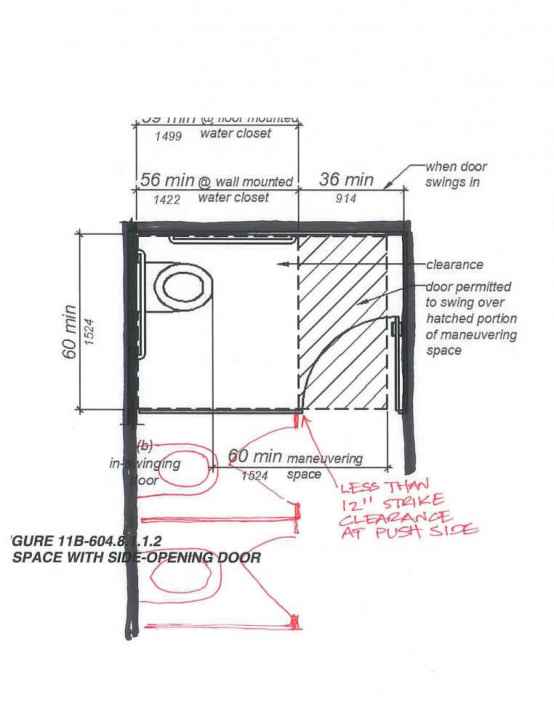Yikes
SAWHORSE
Situation:
Multi-user toilet facility
A long row of toilets with stalls about 4'-9" long. Typical floor mounted 1" think partitions and doors.
At the end of the row is the 8'-3" long accessible stall. Its stall door swings inward towards the toilet.
This door has gravity hinges which swing the door closed, and it has a slide latch for privacy.
So, as seen from outside the accessible stall, the stall door closes, latches, but does nto have 12" strike side clearance due to the adjacent (4'-9" long non-accessible stall) partition.
CBC/ADA would normally require 12" strike side clearance on the push side of a door that is equipped with both a "latch" and a "closer" (the gravity hinges).
However, I contend this doesn't apply to the situation described above, because the latch is only accessed and functional from the inside of the stall, which is the pull side. the outside/push side has no latch. There will never be a situation where a person on the outside will have to actuate a latch in order to open the (self-closing) door to an unoccupied accessible stall. Therefore, as seen form the push side this is functionally equivalent to the door having no latch, and therefore no 12" strike side clearance is required on the push side.
Do you agree?
Multi-user toilet facility
A long row of toilets with stalls about 4'-9" long. Typical floor mounted 1" think partitions and doors.
At the end of the row is the 8'-3" long accessible stall. Its stall door swings inward towards the toilet.
This door has gravity hinges which swing the door closed, and it has a slide latch for privacy.
So, as seen from outside the accessible stall, the stall door closes, latches, but does nto have 12" strike side clearance due to the adjacent (4'-9" long non-accessible stall) partition.
CBC/ADA would normally require 12" strike side clearance on the push side of a door that is equipped with both a "latch" and a "closer" (the gravity hinges).
However, I contend this doesn't apply to the situation described above, because the latch is only accessed and functional from the inside of the stall, which is the pull side. the outside/push side has no latch. There will never be a situation where a person on the outside will have to actuate a latch in order to open the (self-closing) door to an unoccupied accessible stall. Therefore, as seen form the push side this is functionally equivalent to the door having no latch, and therefore no 12" strike side clearance is required on the push side.
Do you agree?

